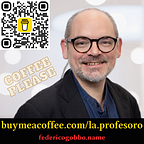Language inventors are not lunatics
Review of “Imaginary languages” by Marina Yaguello (2022)
It’s unbelievable. It happened again.
Marina Yaguello is a renowned French linguist who wrote on interlinguistics matters already in 1984, in a book I read in the 1990s in its English translation, Lunatic Lovers of Languages. She ridicules invented languages since then, when we engaged in a fair academic fight in Palazzo Nuovo, Turin. I was writing my MA thesis on the sociology of Esperanto, The Esperanto Dilemma, then.
Several decades passed. She writes what she calls an update of that book of hers’. And yet false information is spread out to the general public. Deontologically unacceptable. In her box on Esperanto, she claims that the Esperanto community is “limited in number (between one and ten million) but great in motivation”. The reverse is true. First, Esperanto speakers are less than one million, but this number is limited; moreover, the assertion that they are ‘great in motivation’ ignores all the research on the Esperanto identity, which is more nuanced than Yaguello thinks. I recommend, at the very least, the recent book by the anthropologist Guilherme Fians, Esperanto Revolutionaries and Geeks.
But, even more importantly, she asserts that Esperanto “tends to break off into dialects.” And it is not a translation problem: in the original French edition, published in 2006, on p. 109, we read “Dans la pratique, l’espéranto a attendance à se dialectiser ;”. Basically, she ignores all scholarly literature in Esperanto Studies, even if in French!
First, there is no empirical study proving that and never will, as it does not; second, the community of Esperanto speakers is compact and prescriptive, full of grammarnazi and self-proclamed linguists — “I speak, therefore I am a linguist” types. Even more, when she refers to an Esperantist, Petro Stojan (p 20), she omits to present him as such, and it would have sufficed to check on the English Wikipedia.
But the distortion does not only target Esperanto. Look at this excerpt from chapter 2, pp 19–20:
We can picture the logophile in a study crammed with books; all around lie vast quantities of information yet to be collated, classified, listed, and indexed on countless tables and cards. A delirium of naming, taxonomical madness, has seized this solitary figure. Everything in the world awaits its true name, but first the overarching categories and concepts must be identified and arranged, so a system of notation, hierarchies, and models spans the whole universe.
A language inventor is not anymore a lunatic — unlike in the book of 1984 (merci!) — but just “a passionate amateur, in both senses of the word: a lover and a dilettante.”
The book does not refer to any postwar interlinguistics literature, as if nothing had happened after the publication of IALA’s Interlingua in 1951 — which is, ça va sans dire, completely untrue. This is the same vice ofUmberto Eco’s book The Search for the Perfect Language (1999), originally published in Italian in 1993, and translated into many languages, including an Esperanto version.
The most original contribution of the book, which makes a display of the author’s erudition, is the box ‘Families of Constructed Languages’ (pp 84–86), as it puts in order a plethora of language projects (following the definition by the eminent interlinguist Detlev Blanke). Marina Yaguello treats all the invented languages as if they were language projects; no, Blanke would have said replied, a dozen or so of them succeeded in forming a group of activists and a social movement (Volapük, Ido, Occidental/Interlingue, IALA’s Interlingua, still nowadays, and in the past also Latino sine Flexione, Novial, Idiom Neutral, and few others). Esperanto is another story, which was told recently (2015) by Roberto Garvía in a nice book, put in contrast with its ‘rivals’.
The first three parts (chapters 1–9, until p 164) illustrate the case of the language invention, more as a detective novel than a scholarly work. Part IV is entitled ‘The defense and illustration of natural languages’, just to reassure the inadvertent reader not to worry: ‘artificial’ languages are dreamy, fake, just a tool to play God, ‘prisons of mind’ [sic!], while the ‘real’ ones are the natural languages we are used too, English, French, Chinese… no mention of minoritised languages, nor sign languages. Out of the radar.
Curiously, Part IV is a few pages long. The treatment of the vexata quaestio of the Sapir-Whorf hypothesis — which, stricto sensu, never existed, as Sapir had one idea, Whorf another one on the opportunity of a world language — is absolutely too quick to make it justice. In short: the book is a missed opportunity. However, Appendix 2, presenting first-source texts in English, can be helpful for interlinguists and specialists in general.
In conclusion, when the author proclaims: “I have tried to evoke a particular kind of personality — an archetype — and treat it without making any value judgements” (p 27), by the end of the day, I say: yours was a spectacular failure.
